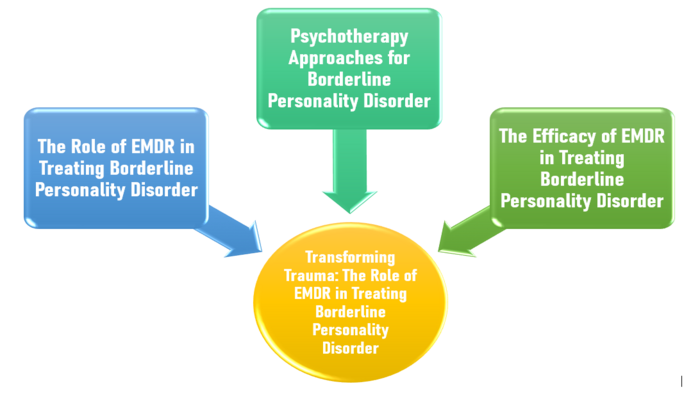Transforming Trauma: The Role of EMDR in Treating Borderline Personality Disorder
The Role of EMDR in Treating Borderline Personality Disorder
DOI:
https://doi.org/10.63175/tjts.7Keywords:
Borderline Personality Disorder, EMDR, Trauma Treatment, Eye Movement Desensitization and ReprocessingAbstract
Borderline personality disorder (BPD) is a complex psychiatric condition marked by emotional dysregulation, unstable interpersonal relationships, and self-harming or suicidal behaviors. It is linked to a combination of biological vulnerabilities, maladaptive early environments, and invalidating caregiver responses, BPD has been addressed through various psychotherapeutic modalities such as Cognitive Behavioral Therapy, Dialectical Behavior Therapy, Schema-focused Therapy, Transference-Focused Psychotherapy, and Mentalization-based Therapy. As research increasingly recognizes the pivotal role of traumatic experiences, interest in trauma-focused interventions for BPD has grown. Therefore, Eye Movement Desensitization and Reprocessing (EMDR) therapy, rooted in the Adaptive Information Processing model, offers a structured approach to integrate and resolve trauma-related memories that may underlie BPD’s clinical presentation. Although initially developed and validated for Post-Traumatic Stress Disorder, EMDR’s application in BPD treatment shows promise, especially when tailored to address the unique challenges of this population. This review synthesizes the current literature on EMDR’s theoretical rationale, clinical adaptations, and preliminary empirical support for its efficacy in BPD. Integrating EMDR into multidisciplinary treatment protocols may advance individualized, effective strategies that improve outcomes and overall quality of life for individuals with BPD.
Key Words: Borderline Personality Disorder, EMDR, Trauma Treatment
References
1. Stoffers-Winterling JM, et al. The effectiveness of psychotherapy for borderline personality disorder: A systematic review and meta-analysis. Psychol Med. 2012;42(5):1–10.
2. Vogt KS, Norman P. Understanding the role of trauma in borderline personality disorder: A review of the literature. Pers Disord Theory Res Treat. 2019;10(3):1–10.
3. Levy KN, Ellison WD, Scott LN, Bernecker SL. Attachment style. J Clin Psychol. 2011;67(2):193-203. doi:10.1002/jclp.20756.
4. Kellogg SH, Young JE. Schema therapy for borderline personality disorder: A review of the literature. J Pers Disord. 2006;20(1):1–10.
5. Yuan Y., Lee H., Eack SM., Newhill, CE. A Systematic Review of the Association Between Early Childhood Trauma and Borderline Personality Disorder. J Pers Disord.2023;37(1):16–35. https://doi.org/10.1521/pedi.2023.37.1.16
6. Bozzatello P., Rocca P., Baldassarri L., Bosia M., Bellino, S. The Role of Trauma in Early Onset Borderline Personality Disorder: A Biopsychosocial Perspective. Front psychiatry. 2021;12: 721361. https://doi.org/10.3389/fpsyt.2021.721361
7. Peng W., Liu Z., Liu Q., Chu J., Zheng K., Wang J., Wei H., Zhong M., Ling Y., Yi J. Insecure attachment and maladaptive emotion regulation mediating the relationship between childhood trauma and borderline personality features. Depress Anxiety. 2020;38:28-39. https://doi.org/10.1002/da.23082.
8. Slee NM, et al. The relationship between trauma and borderline personality disorder: A review of the literature. Clin Psychol Rev. 2008;28(4):1–10.
9. Linehan MM, Comtois KA, Murray AM, et al. Two-Year Randomized Controlled Trial and Follow-up of Dialectical Behavior Therapy vs Therapy by Experts for Suicidal Behaviors and Borderline Personality Disorder. Arch Gen Psychiatry. 2006;63(7):757–766. doi:10.1001/archpsyc.63.7.757.
10. Lynch TR, et al. Dialectical behavior therapy for borderline personality disorder: A meta-analysis. J Consult Clin Psychol. 2007;75(6):1–10.
11. Yeomans FE, Clarkin JF, Kernberg OF. A primer on borderline personality disorder: Theoretical and clinical perspectives. J Pers Disord. 2015;29(1):1–10.
12. Brown S, Shapiro F. EMDR in treating borderline personality disorder: A case study. J Clin Psychol. 2006;62(1):1–15.
13. Shapiro F. Eye movement desensitization and reprocessing: Basic principles, protocols, and procedures. 2nd ed. New York: Guilford Press; 2001.
14. Leeds AM, Mosquera D. The role of emotion regulation in the relationship between borderline personality disorder and suicidal behavior. Pers Disord Theory Res Treat. 2012;3(2):145–155. doi:10.1037/a0025161.
15. Stickgold R. EMDR: A new treatment for trauma. Am J Psychiatry. 2002;159(8):1–10.
16. van den Hout MA, et al. The effectiveness of EMDR therapy for PTSD: A meta-analysis. J Trauma Dissociation. 2001;2(1):1–10.
17. Schore AN. The effects of early relational trauma on the development of the self. J Am Psychoanal Assoc. 2001;49(1):1–10.
18. Main M, Hesse E. Parents' unresolved traumatic experiences are related to infants' disorganized attachment status: Is frightened or frightening parental behavior the linking mechanism? In: Attachment in the preschool years: Theory, research, and intervention. Chicago: University of Chicago Press; 1990:161–182.
19. Mosquera D, Gonzalez A, Leeds AM. Early experience, structural dissociation, and emotional dysregulation in borderline personality disorder: The role of insecure and disorganized attachment. Borderline Pers Disord Emotion Dysregulation. 2014;1(15):1–15. doi:10.1186/2051-6673-1-15.
20. Courtois CA, Ford JD, Cloitre M. The role of trauma in the development of borderline personality disorder. J Trauma Dissociation. 2009;10(1):1–10.
21. Mosquera D. EMDR therapy for borderline personality disorder: A review of the literature. J Trauma Dissociation. 2012;13(1):1–10.
22. Gonzalez A, Mosquera D. The impact of trauma on borderline personality disorder: A review of the literature. J Pers Disord. 2012;26(1):1–10.
23. Hafkemeijer, L., Slotema, K., Haard, N. D., & Jongh, A. D. (2023). Case report: Brief, intensive EMDR therapy for borderline personality disorder: results of two case studies with one year follow-up. Frontiers in Psychiatry, 14, 1283145.
24. Krause-Utz, A. Dissociation, trauma, and borderline personality disorder. Bord Personal Disord Emot Dysregul. 2022;9(1):14.https://doi.org/10.1186/s40479-022-00184-y
25. Wilhelmus J, et al. The effectiveness of EMDR therapy for individuals with borderline personality disorder: A randomized controlled trial. J Trauma Dissociation. 2023;24(1):1–20.
26. Taylor J, et al. The role of attachment in borderline personality disorder: A review of the literature. Clin Psychol Rev. 2003;23(5):679–700.
27. Snoek J, et al. EMDR for the treatment of borderline personality disorder: A systematic review and meta-analysis. J Affect Disord. 2020;274:1–10.
28. Slotema CW, et al. The efficacy of EMDR therapy in the treatment of PTSD: A systematic review and meta-analysis. Psychol Med. 2019;49(2):1–10.

Downloads
Published
How to Cite
Issue
Section
License
Copyright (c) 2025 Derin Kubilay

This work is licensed under a Creative Commons Attribution 4.0 International License.







